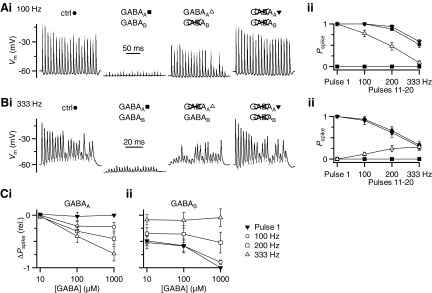Fig. 1.
Effects of γ-aminobutyric acid receptor (GABAR) activation on bushy cell (BC) firing. Ai: example BC firing pattern for 100-Hz stimulation in control (left), with GABA puff (left, middle), with GABA puff in the presence of CGP55845 (right middle), and with GABA puff in the presence of CGP55845 + bicuculline (right). ii: average effects from 8 experiments similar to i and at different frequencies. BC spike probability (Pspike) is quantified separately for the first pulse in the train (pulse 1) and pulses 11–20 for trains of different frequencies. Symbols match the pharmacological conditions in i. GABA application alone decreases the firing probability throughout the train. CGP55845 completely restores spiking for the first pulse and also significantly increases the spike probability for pulses 11–20 at lower frequencies of stimulation. Bi: similar experiment to A, but showing example traces at 333-Hz stimulation and with the effects of GABA in the presence of bicuculline (right middle) applied before CGP55845. ii: average effects from 8 experiments, similar to i. Bicuculline application restores spiking to control levels for pulses 11–20 at 333 Hz, but has no effect on the first pulse and a weaker effect at 100- and 200-Hz stimulation. C: change in spike probability (ΔPspike) for the experiments in A and B calculated relative to control for GABA application in the presence of (i) CGP55845 to evaluate the contribution of GABAARs or (ii) bicuculline to evaluate the contribution of GABABRs. Changes were quantified as ΔPspike = (Pspikedrug/Pspikectrl) − 1. Each data point is the average of 6–8 cells. GABAAR activation has little effect on the first pulse, but it reduces BC spiking for pulses 11–20. This effect increases with firing frequency and GABA concentration. GABABR activation, by contrast, reduces spiking for pulse 1 as well as throughout the train for lower-frequency stimulation.

